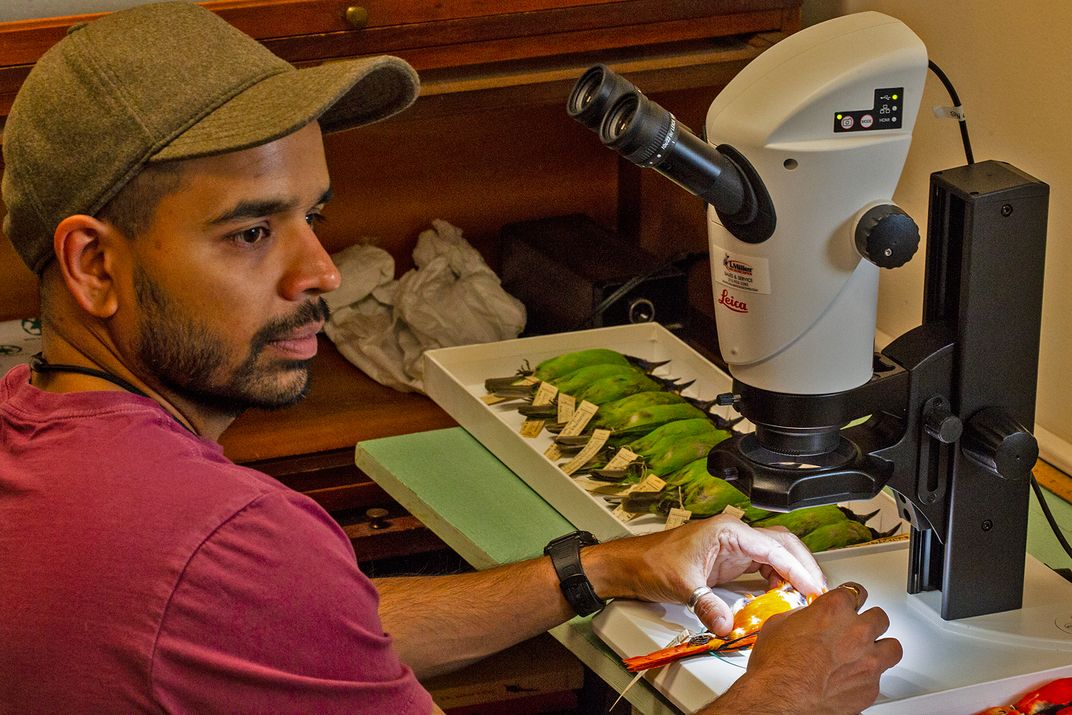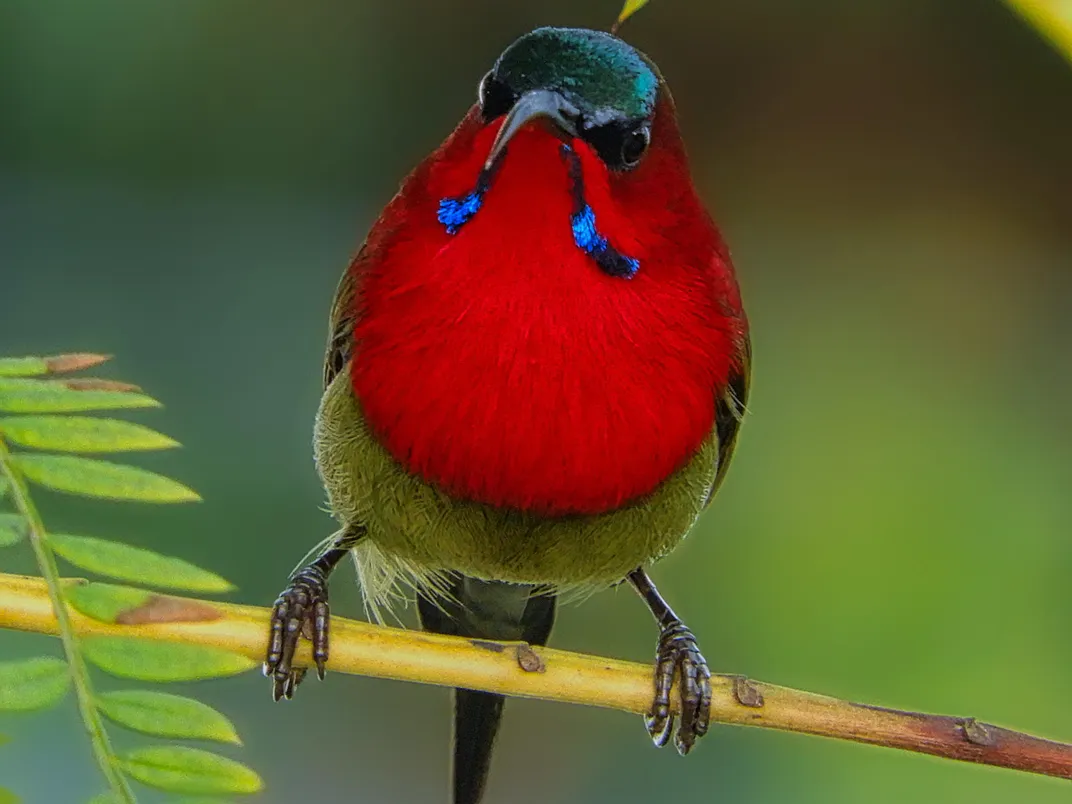Himalayan Songbirds Adapted to the Cold by Sporting Thicker Down ‘Jackets’
High-elevation birds might use their downy feathers to keep from wasting energy shivering to stay warm
/https://tf-cmsv2-smithsonianmag-media.s3.amazonaws.com/filer/fa/c6/fac69157-fbdb-47f0-9682-e0714551ed1a/a_-_sahas_barve_-_fulvetta_chavan.jpg)
The old adage “free as a bird” doesn’t quite apply in the world’s tallest mountain ranges. Instead, songbird species are confined to specific elevations, where they have evolved to fit that particular climate.
The crimson sunbird, for instance, lives from the foot of the Himalayas up to about 1,600 feet. The green-tailed sunbird, its evolutionary cousin, lives between about 5,000 feet to 10,000 feet of elevation, while another close relative, the fire-tailed sunbird, rules the roost from about 11,000 feet to 13,000 feet.
Scientists who study birds are still unraveling the factors that keep each bird in its elevational niche. Research published this week in the journal Ecography adds a new piece to the puzzle: the higher a songbird species lives in the Himalayas—and the colder temperatures it faces, because of the altitude—the thicker its downy feather layer. The finding could help researchers predict how songbirds will adapt to a changing climate.
“Insulation is pretty important,” says vertebrate zoologist Sahas Barve, a Peter Buck fellow at the Smithsonian’s National Museum of Natural History and the first author on the new study. Temperatures in the Himalayas regularly drop below freezing at night. Birds, however, need to keep their bodies at about 104 degrees Fahrenheit.
“The straight-line distance between the outside air and the bird's heart is less than an inch. So, it has to maintain that temperature difference across that little barrier,” says Barve.
Feathers provide key insulation. To investigate the ways that feathers evolved to keep birds warm, Barve measured the downy feathers of more than 200 species of Himalayan songbird specimens held in the museum’s vast collections, where rows and rows of file-like cabinets hold taxidermied examples of the world’s avian species.
/https://tf-cmsv2-smithsonianmag-media.s3.amazonaws.com/filer/ad/8c/ad8c8651-bd4f-4818-b4fc-c3a549be9ddd/b_-_birdcollnfinalprint.jpg)
“Irrespective of body size, birds that live at the bottom of the mountain have less downy feathers than birds that live at the top of the mountain,” says Barve.
Birds are warm-blooded, like humans, so they use a familiar strategy to heat themselves up when the temperature falls—shivering. But at an elevation of 12,000 feet, nighttime temperatures can drop to between 0- and 20-degrees Fahrenheit. Birds in the Himalayas have to shiver so much to stay warm that they can lose a fifth of their body weight in one night. Birds sometimes starve to death because they burn so many calories simply because they are shivering.
As climate change continues to alter weather patterns, extreme cold events could occur more often and last longer each time. That could put a lot of stress on mountain-dwelling bird populations. “To fully understand how birds will deal with changing temperatures, we need to understand this basic, fundamental concept of how birds use their feathers to stay warm,” says Barve.
Barve analyzed 1,715 specimens from the museum’s collections representing 249 Himalayan songbird species. The species were gathered from a 1,000-mile span of the Himalayas, and at elevations from 246 feet to 16,150 feet. The species were as small as the black-face warbler, which weighs just a fraction of an ounce, to the half-pound blue whistling thrush. The oldest specimen included in the study was a blue rock thrush collected in 1876.

By measuring the length of the downy section of the feather, and calculating the proportion of the total feather length that was committed to down, along with other measurements of the down’s specific characteristics, Barve was able to arrive at his tantalizing conclusion. Although there had been small studies of a few species’ downy feathers, none had been done on this scale.
“I guess it's just one of those questions that slipped under the radar,” says University of Chicago ornithologist Trevor Price, whose research focuses on the evolution of Himalayan birds and who wasn’t involved in the study. “This is something that really needed to be done and, with an impressive sample size, they have shown that there is a correlation between insulative properties of feathers and elevation.”
Birds evolved to meet the challenges of their elevation’s climate relatively recently. Scientists know this because, if a sharp-eyed birdwatcher were to climb a mountain, they would notice that at a certain elevation, one species of finch will give way to another finch.
The factors that keep each species on its turf vary. Related species may compete for similar food sources, but they may also learn different behaviors to deal with their own niche’s challenges. (A high-elevation bird needs to insulate its nest with feathers, while a low-altitude bird needs to protect itself from pests, for example.)

Downy feather length appears to be one more thing that sets species apart after they have evolved at different altitudes. But the next step in this line of research is to find out whether the thicker layer of down actually makes a bird better at conserving its body heat. Barve is conducting further research with specimens in the museum’s collections to answer that question, although pandemic-related restrictions have slowed the process.
The Ecography study focuses on specimens collected during breeding season which means that the birds are preserved with their summer feathers. It’s a practical problem; researchers would have a hard time hiking up to the highest peaks of the Himalayas in the middle of winter. But birds molt, swapping their summer plumage for warmer “jackets” of feathers in the winter weather, Trevor Price points out. The study also includes species that migrate away from the Himalayas in colder months.
“If you were to redo this for the winter, I bet you the correlation would be stronger,” says Price.
The study not only sheds light on a longstanding question in bird evolution, but also shows the ways that museum collections can be used in research. It would not have been practical to study so many species in the wild, but in a museum, they’re all stored in one place.
The new research makes use of the museum’s collections “in new ways that we never would have thought of in the past,” says the museum’s Carla Dove, who manages the Bird Identification Lab and who was a co-author of the study.
“[When] they were assembling these collections back in the day, they never even really thought about climate change as a global issue,” adds Dove. “And to use the collections today to try and help us answer questions about birds and climate change is just one example of how valuable our collections are for the future.”